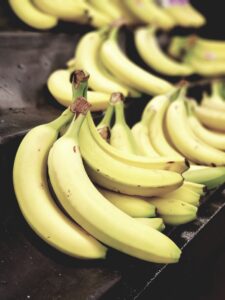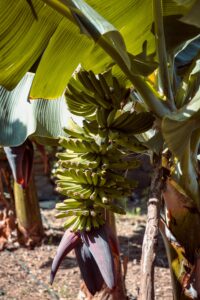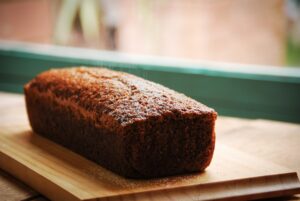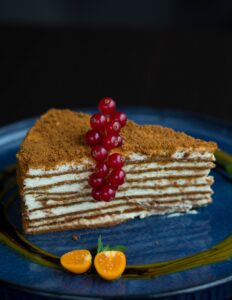Bananas are often referred to as a “miracle fruit” because they are a nutritious and convenient food that can provide a number of health benefits. They are a good source of potassium, fibre, and various vitamins and minerals, and they are low in calories and fat. Bananas are also easy to find, inexpensive, and can be eaten raw or used in a variety of dishes and recipes. Some people may consider bananas to be a “miracle fruit” due to their versatility and potential health benefits, but it is important to remember that they are just one type of food and should be consumed as part of a varied and balanced diet. There are many potential benefits of consuming bananas, as they are a nutritious and convenient food.
Bananas are a good source of potassium, which is an essential mineral that helps  regulate heart function, fluid balance, and muscle function. Bananas too are also a good source of fibre, which can help promote regular bowel movements, maintain a healthy weight, and lower cholesterol levels. It’s a good source of vitamin B6, which is important for brain function, the immune system, and the metabolism of proteins and carbohydrates and contains many other important vitamins and minerals, such as vitamin C, manganese, and magnesium.
regulate heart function, fluid balance, and muscle function. Bananas too are also a good source of fibre, which can help promote regular bowel movements, maintain a healthy weight, and lower cholesterol levels. It’s a good source of vitamin B6, which is important for brain function, the immune system, and the metabolism of proteins and carbohydrates and contains many other important vitamins and minerals, such as vitamin C, manganese, and magnesium.
When it comes to convenience, bananas are widely available and easy to find. It can be eaten raw or used in a variety of dishes and recipes. It is relatively inexpensive, making them an accessible and convenient food choice. Overall, the biggest benefit of bananas may depend on an individual’s specific health needs and goals. It is important to consume a varied and balanced diet that includes a variety of different types of foods to ensure that you are getting all of the nutrients that your body needs.
Bananas are native to tropical regions of Southeast Asia and the South Pacific. They are believed to have been cultivated for the first time in the region that is now present-day Papua New Guinea. From there, they spread to other parts of Southeast Asia and eventually to the rest of the world. There are over 1,000 varieties of bananas, but the most common type found in grocery stores is the Cavendish banana, which is the type most often exported around the world. Other common varieties of bananas include plantains, red bananas, and apple bananas.
 Today, bananas are grown in many tropical and subtropical countries around the world, including countries in Latin America, Africa, and Asia. Some of the top banana-producing countries include India, China, the Philippines, Indonesia, and Ecuador.
Today, bananas are grown in many tropical and subtropical countries around the world, including countries in Latin America, Africa, and Asia. Some of the top banana-producing countries include India, China, the Philippines, Indonesia, and Ecuador.
The benefits of consuming this fruit are evident and should be promoted to all age groups. However, certain age groups may benefit more from certain nutrients found in bananas. For example:
- Children: Bananas are a good source of potassium, which is important for proper growth and development in children. They are also a good source of fibre, which can help promote regular bowel movements and prevent constipation.
- Adults: Bananas are a good source of potassium, which is important for maintaining heart health, regulating blood pressure, and supporting muscle function. They are also a good source of fibre, which can help maintain a healthy weight, lower cholesterol levels, and promote regular bowel movements.
- Older adults: As we age, our bodies may become less efficient at absorbing and using certain nutrients, such as potassium. Consuming bananas, which are a good source of potassium, may help older adults maintain an adequate intake of this important nutrient.
Is there anything we can do with the banana peels instead of throwing them away?
Yes, the banana skin can be used for a number of purposes. Here are a few examples:
- Gardening: Banana peels can be used as a natural fertilizer for plants. They contain nutrients such as potassium, phosphorus, and calcium, which can help improve soil fertility and promote healthy plant growth. To use banana peels as fertilizer, simply chop them up and bury them in the soil around the base of the plant.
- Pest control: Banana peels can also be used to deter pests in the garden. Slugs and snails, for example, do not like crawling over rough surfaces, so placing banana peels around plants can help keep these pests away.
- Skincare: Banana peels can be used to treat various skin conditions, such as acne, warts, and age spots. The peels contain compounds that may have anti-inflammatory and antioxidant properties, which can help reduce redness and swelling and promote healthy skin. To use a banana peel for skin care, simply rub the inside of the peel over the affected area and let it sit for a few minutes before rinsing off.
- Polishing: Banana peels can also be used to polish leather and silver. Simply rub the inside of the peel over the surface you want to polish, and then wipe it clean.
Overall, while banana peels are often discarded, they can have a number of useful purposes. It is always worth considering ways to make use of food scraps and minimize waste.
Another way to use bananas is flour made from ground, dehydrated bananas. It is a type of flour that is often used as a gluten-free alternative to wheat flour. Banana flour has a unique flavour and can be used in a variety of recipes, including bread, cakes, cookies, and pancakes.
type of flour that is often used as a gluten-free alternative to wheat flour. Banana flour has a unique flavour and can be used in a variety of recipes, including bread, cakes, cookies, and pancakes.
Banana flour is high in fibre and has a lower glycemic index than wheat flour, meaning it may have a slower impact on blood sugar levels. It is also a good source of potassium and other nutrients, such as vitamin C, vitamin B6, and manganese.
To use banana flour in recipes, it is usually necessary to adjust the amount of liquid used, as banana flour absorbs more moisture than wheat flour. It is also often necessary to add a leavening agent, such as baking powder or baking soda, to help the baked goods rise.
Overall, banana flour can be a nutritious and gluten-free alternative to wheat flour, but it is important to consider the flavour and texture it may add to a recipe, as it can be quite distinct. It is also worth noting that banana flour is not a complete protein, so it should not be relied upon as the sole source of protein in a diet.
Here are two dessert recipes using bananas:
Banana Bread
 Ingredients:
Ingredients:
- 1 1/2 cups all-purpose flour
- 1 teaspoon baking powder
- 1/2 teaspoon baking soda
- 1/4 teaspoon salt
- 1/2 cup unsalted butter, softened
- 3/4 cup granulated sugar
- 2 large eggs
- 1 teaspoon vanilla extract
- 3 ripe bananas, mashed
- 1/2 cup chopped nuts (optional)
Instructions:
- Preheat your oven to 350°F (180°C). Grease a 9×5-inch loaf pan and set aside.
- In a medium bowl, whisk together the flour, baking powder, baking soda, and salt.
- In a separate large bowl, beat together the butter and sugar until light and fluffy. Beat in the eggs, one at a time, followed by the vanilla extract.
- Add the mashed bananas to the butter mixture and mix until well combined. Gradually add the dry ingredients to the wet ingredients, mixing just until combined. Stir in the nuts, if using.
- Pour the batter into the prepared loaf pan and smooth the top with a spatula.
- Bake for 60-70 minutes, or until a toothpick inserted into the centre comes out clean. Let the bread cool in the pan for 10 minutes, then transfer it to a wire rack to cool completely.
Banana Cream Pie
Ingredients:
- 1 1/2 cups graham cracker crumbs
- 6 tablespoons butter, melted
- 1/4 cup granulated sugar
- 1 cup heavy cream
- 1/2 cup whole milk
- 1/2 cup granulated sugar
- 3 tablespoons cornstarch
- 1/4 teaspoon salt
- 3 large egg yolks
- 1 teaspoon vanilla extract
- 2 tablespoons unsalted butter
- 3 medium bananas, sliced
- 1 cup whipped cream (homemade or store-bought)

Instructions:
- Preheat your oven to 350°F (180°C).
- In a medium bowl, combine the graham cracker crumbs, melted butter, and 1/4 cup of sugar. Press the mixture into the bottom and up the sides of a 9-inch pie dish. Bake for 8-10 minutes, or until the crust is lightly golden. Let the crust cool completely.
- In a medium saucepan, combine the heavy cream, milk, 1/2 cup of sugar, cornstarch, and salt. Cook over medium heat, stirring constantly until the mixture thickens and comes to a boil.
- In a small bowl, whisk together the egg yolks. Slowly pour a small amount of the hot cream mixture into the yolks, whisking constantly, to temper the eggs. Pour the egg mixture back into the saucepan with the remaining cream mixture and cook, stirring constantly, for an additional 2-3 minutes, or until the mixture thickens further. Remove from the heat and stir in the vanilla extract and butter.
- Arrange the sliced bananas on the bottom of the cooled crust. Pour the cream mixture over the bananas and smooth the top with a spatula. Cover the pie with plastic wrap and refrigerate for at least 2 hours, or until the pie is set.
- Before serving, top the pie with whipped cream and slice it into wedges. Enjoy!

